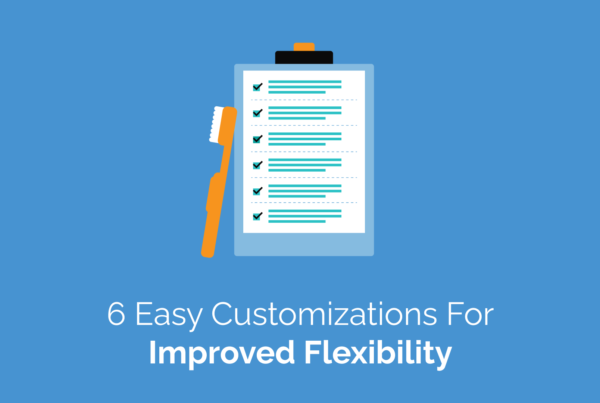Today, the healthcare industry heavily relies on data collection on a day-to-day basis. From electronic health records (EHR) to research-based outcomes, care professionals are constantly turning to technology and digital solutions for information to properly assist patients in need. As detailed by the Agency for Healthcare Research and Quality, care providers calculate patient solutions and satisfaction by utilizing various public and private data collection systems, such as health surveys, electronic health records and more.
In the world of dentistry, data collection supports dental health and wellness by not only providing patients with preventative dental care advice, but also proactive solutions in the event of an oral emergency.
In an effort to better understand the correlation between data collection and improved dental health and wellness, let’s take a closer look at the opportunities presented via dental EHR and the importance of preventative oral care. We’ll also assess how a cloud-based academic software solution can be used to collect data and support dental hygiene students and staff on their journey to support patient dental health and wellness.
Why is Preventative Oral Care So Important?
While dental care as a means of protecting the teeth, gums and tongue is important, safeguarding the mouth against harmful bacteria goes much deeper than what’s presented on the surface. As reported by the Office of Disease Prevention and Health Promotion, dental health and wellness correlate directly to overall health across the body.
Oral bacteria and dental decay have been found to lead to various other health-related conditions and can impair what many would consider some of the simplest of actions, such as smiling, smelling, chewing and tasting. By prioritizing dental health and wellness and taking preventative oral care measures seriously, there’s an opportunity to improve how the mouth functions while simultaneously reducing the risk of developing corresponding ailments and diseases that impact the entire body.
How Dental EHR Uses Data to Inform Better Decision-Making
Digital advancements have made a major impact on many industries and the way they function. This is certainly true for the world of dentistry; dental hygiene schools and offices around the world rely on technology for tasks involving central workflow management and more.
In general, scheduling and showing up for regular dental visits is not always easy for patients. And those who have limited access to preventive dental care services are at an increased risk for experiencing common oral diseases such as dental decay or even oral cancer, according to the National Institute of Dental and Craniofacial Research. Some contributing factors include reduced income, lack of insurance, being without transportation or limited flexibility in taking time off of work.
Thankfully, however, digital opportunities are making it easier for those seeking greater access to oral care to get the assistance they need, especially when data-driven decision-making based on the use of dental EHR is involved, according to the Institute of Medicine (US) Subcommittee on Standardized Collection of Race/Ethnicity Data for Healthcare Quality Improvement:
“Health information technology (Health IT) may have the potential to improve the collection and exchange of self-reported race, ethnicity, and language data, as these data could be included, for example, in an individual’s personal health record (PHR) and then utilized in electronic health record (EHR) and other data systems.”
By better integrating data collection and access across the board in healthcare settings, more patients can receive the quality care they need because solutions are form-fitted to meet specific needs and bypass common barriers.
In a recent article from DentistryIQ, Chris Salierno, DDS, chief editor of Dental Economics and the editorial director of the Principles of Practice Management, shared another interesting point about implementing data collection in healthcare settings: Data collection, for many facilities, can be seen as a competitive advantage. A company that knows how to collect, analyze and leverage data becomes more profitable because it can provide better service to its clients, or in this case, patients.
“This is an exciting time for the dental industry,” Salierno wrote. “We are in the midst of the Third Industrial Revolution and the pace of innovation is simply staggering. Companies are gaining new insights into how to develop software, hardware, and materials. If those insights are based on user data, they could lead to product features that not only create better user experiences and outcomes but also ones that build lasting barriers to the competition.”
The Future of Data-Driven Decision-Making with axiUm Ascend
Interoperability, or the “complete access, exchange, and use of all electronically accessible health information for authorized use under applicable state or federal law” as stated by 21st Century Cures Act, allows for the improved exchange of health information and data collection. Interoperability enables a steady flow of accurate data, thus enabling your dental hygiene school or practice to make the best decisions for patients based on detailed reports and high-level information. Interoperability in healthcare, specifically in dentistry, is greatly achievable with a practice management system in place.
Cloud-based software, like axiUm Ascend, allows dental hygiene schools and practices to take advantage of the opportunity to access data when they want, wherever they want. When there’s unlimited access to data, and peace of mind in terms of disaster recovery and automatic backup offered by the cloud, dental professionals are equipped to make well-informed decisions that support dental health and wellness for all patients at any given moment.
Interested in understanding the additional benefits of cloud-based dental software? Want to learn more about how you can implement and optimize axiUm at your dental organization? Contact us directly or request a demo today to get started.
Sources:
https://www.ahrq.gov/research/findings/final-reports/iomracereport/reldata5.html
https://www.healthypeople.gov/2020/topics-objectives/topic/oral-health
https://www.nidcr.nih.gov/research/data-statistics/surgeon-general
https://www.healthit.gov/sites/default/files/cures/2020-03/ONC_Cures_Act_Final_Rule_03092020.pdf
https://www.exansoftware.com/understanding-interoperability-in-healthcare-and-dentistry/
https://www.exansoftware.com/6-ways-to-optimize-axium-at-your-dental-organization/
https://www.ncbi.nlm.nih.gov/books/NBK219747/





